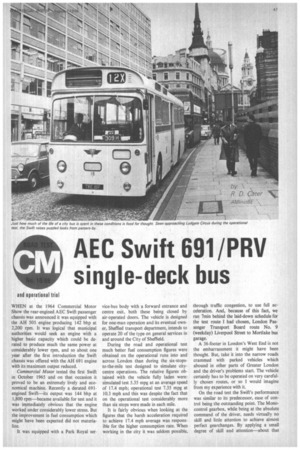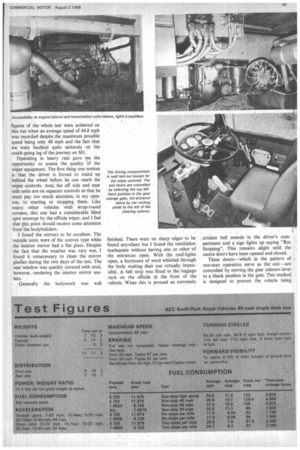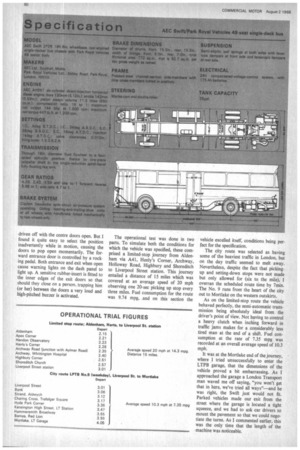ert i AEC Swift 691/PRV
Page 49

Page 50

Page 51

Page 52

If you've noticed an error in this article please click here to report it so we can fix it.
single-deck bus
WHEN at the 1964 Commercial Motor Show the rear-engined AEC Swift passenger chassis was announced it was equipped with the AH 505 engine producing 142 bhp at 2,200 rpm. It was logical that municipal authorities would seek an engine with a higher basic capacity which could be derated to produce much the same power at considerably lower rpm, and so about one year after the first introduction the Swift chassis was offered with the AH 691 engine with its maximum output reduced.
Commercial Motor tested the first Swift in October 1965 and on that occasion it proved to be an extremely lively and economical machine. Recently a derated 691engined Swift—its output was 14-4 bhp at 1,800 rpm—became available for test and it was immediately obvious that the engine worked under considerably lower stress. But the improvement in fuel consumption which might have been expected did not materialize.
vice-bus body with a forward entrance and centre exit, both these being closed by air-operated doors. The vehicle is designed for one-man operation and its eventual owner, Sheffied transport department, intends to operate 20 of the type on general services in and around the City of Sheffield.
During the road and operational test much better fuel consumption figures were obtained on the operational runs into and across London than during the six-stopsto-the-mile test designed to simulate citycentre operations. The relative figures obtained with the vehicle fully laden were: simulated test 5.35 mpg at an average speed of 17.4 mph; operational test 7.35 mpg at 10.3 mph and this was despite the fact that on the operational test considerably more than six stops were made in each mile.
It is fairly obvious when looking at the figures that the harsh acceleration required to achieve 17.4 mph average was responsible for the higher consumption rate. When working in the city it was seldom possible, through traffic congestion, to use full acceleration. And, because of this fact, we ran 7min behind the laid-down schedule for the test route I had chosen, London Passenger Transport Board route No. 9 (weekday) Liverpool Street to Mortlake bus garage.
A 36-footer in London's West End is not the embarrassment it might have been thought. But, take it into the narrow roads crammed with parked vehicles which abound in other parts of Greater London and the driver's problems start. The vehicle certainly has to be operated on very carefully chosen routes, or so I would imagine from my experience with it.
On the road test the Swift's performance was similar to its predecessor, ease of control being the outstanding point. The Monocontrol gearbox, while being at the absolute command of the driver, needs virtually no skill and little attention to achieve almost perfect gearchanges. By applying a small degree of skill and attention—about that amount which one can spare for such things when operating in congested traffic —smooth and unobtrusive changes can be effected. The silky transmission permits the vehicle to be driven down to 10 mph in top gear with no signs of distress from shaft or axle. Acceleration from this speed is quite startling and it was two seconds faster than the 505 despite the extra half-ton and higher axle ratio.
The test vehicle was not equipped with power steering—the low front-axle weight of 3 ton 13ewt hardly made this necessary. All the time one is actually on the road with the vehicle, the steering is pleasantly light and positive. Only when very close-quarter manoeuvring is required does the need for a bit Of "beef' show up. Another point I noticed with the steering was that certain movements of the front suspension caused the machine to veer slightly off course. I had the impression that this was due to a variation in steering geometry with deflection of the front springs, because it was possible to avoid the deviation by sensing a load that was being applied to the steering gear and allowing the wheel to turn slightly, so accommodating changing attitudes of the drag link.
Wet weather curtailed brake-testing activities somewhat. Even so it was obvious that the braking system is well up to the job. Its action is smooth and progressive and very controllable, which is most important on a passenger vehicle where harsh braking effect is uncomfortable—or even dangerous —to the passengers. When the previous Swift was tested the results of the brake tests were extremely good and, as the latest model had wider front brakes—they are• 6 in. 'wide compared to 5 in.—there is no reason to suppose that those on the test vehicle will not give as good results. On the first Swift the figures recorded were 23.1ft (18.7ft /s2) from 20 mph and 50.9ft (19ft /2) from 30 mph. Tapley readings were recorded despite the bad weather on this test and they proved to be, from 20 mph 76 per cent, and from 30 mph, 61 per cent.
The Swift, with its engine and transmission tucked away behind the rear axle is an extremely pleasant vehicle to drive. Despite the fact that one of the floor traps was 'partially open during the test—to accommodate the test tank pipework—the noise level at the front of the vehicle was commendably low. Towards the rear of the vehicle, however, even when I covered the hatch with sandbags, I found the noise a little wearisome after riding some 25 miles in various seats behind the rear axle.
The riding characteristics both laden and unladen are impeccable. At no point in the vehicle is pattering of the axles felt. On badly cambered corners only the slightest tendency to roll was noticeable, in fact throughout the test the stiffness of the ride was quite amazing when one considered how soft the leaf-spring suspension was when unladen. The silence of the ride in the forward section of the body was spoiled by the lid of a first-aid locker which rattled inceisantly.
Although not equipped for motorway operation, the Swift was subjected to a full-throttle test. The best fuel consumption figures Of the whole test were achieved on this run when an average speed of 44.8 mph was recorded despite the maximum possible speed being only 48 mph and the fact that we were baulked quite seriously on the south-going leg of the journey on MI.
Operating in heavy rain gave me the opportunity to assess the quality Of the wiper equipment. The first thing one notices is that the driver is forced to stand 'up behind the wheel before he can reach the wiper controls. And, the off side and near side units are on separate controls so that he must pay too much attention, in my opinion, to starting or Stopping them. Like many other vehicles with wrap-round screens, this one had a considerable blind spot unswept by the offside wiper, and I feel that this point should receive some attention from the bodybuilders.
I found the mirrors to be excellent. The outside units were of the convex type while the interior mirror had a flat glass. Despite the fact that the weather was very wet, I found it unnecessary to clean the mirror glasses during the two days of the test. The rear window was quickly covered with mud, however, rendering the interior mirror useless.
Generally the bodywork was well finished. There were no sharp edges to be found anywhere but I found the ventilation inadequate without having one or other of the entrances open. With the roof-lights open, a hurricane of wind whistled through the body making their use virtually impossible. A bell strip was fitted to the luggage rack on the offside at the front of the vehicle. When this is pressed an extremely
strident bell sounds in the driver's cornpartment and a sign lights up saying "Bus Stopping". This remains alight until the centre doors have been opened and closed.
These doors—which in the pattern of one-man operation serve as the exit—are controlled by moving the gear selector-lever to a blank position in the gate. This method is designed to prevent the vehicle being driven off with the centre doors open. But I found it quite easy to select the position inadvertently while in motion, causing the doors to pop open momentarily. The forward entrance door is controlled by a rocking pedal. Both entrance and exit when open cause warning lights on the dash panel to light up. A sensitive rubber-insert is fitted to the inner edges of the exit doors so that should they close on a person, trapping him (or her) between the doors a very loud and high-pitched buzzer is activated. The operational test was done in two parts. To simulate both the conditions for which the vehicle was specified, these comprised a limited-stop journey from Aldenham via A41, Henly's Corner, Archway, Holloway Road, Highbury and Shoreditch to Liverpool Street station. This journey entailed a distance of 15 miles which was covered at an average speed of 20 mph observing one 20-sec picking up stop every three miles. Fuel consumption for the route was 9.74 mpg, and on this section the vehicle excelled itself, conditions being perfect for the specification.
The city route was selected as having some of the heaviest traffic in London, but on the day traffic seemed to melt away. Nevertheless, despite the fact that pickingup and setting-down stops were not made but only allowed for (six to the mile), I overran the scheduled route time by 7min. The No. 9 runs from the heart of the city out to Mortlake on the western outskirts.
As on the limited-stop route the vehicle behaved perfectly, the semi-automatic transmission being absolutely ideal from the driver's point of view. Not having to control a heavy clutch when inching forward in traffic jams makes for a considerably less tired man at the end of a shift. Fuel consumption at the rate of 7.35 mpg was recorded at an overall average speed of 10.3 mph.
It was at the Mortlake end of the journey, where I tried unsuccessfully to enter the LTPB garage, that the dimensions of the vehicle proved a bit embarrassing. As I approached the garage a London Transport man waved me off saying, "you won't get that in here, we've tried all ways"-and he was right, the Swift just would not fit. Parked vehicles made our exit from the street where the garage is located a tight squeeze, and we had to ask car drivers to mount the pavement so that we could negotiate the turns. As I commented earlier, this was the only time that the length of the machine was noticeable.




































































































